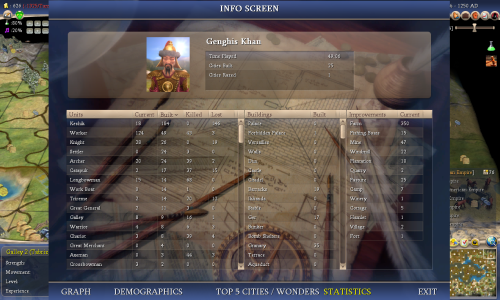Agr/imp Mongolia + always war just pushes us towards early war and conquest by the Keshiks. Therefore, the fact that we are on the island, I took it not only as a plus, but also as a minus. For such a war, we need a fleet of galleys, triremes are needed to protect galleys, in addition, it is more difficult to defend an island with a bunch of coastal cities than 2-3 front-line cities on the "continent". All this means a later war, which means stronger AI resistance. or you need to teach knights / cuirassiers, which I really didn't want. So, I built a Great Lighthouse for maintain the economy, for the protection of the sea and for the forges, I built an Oracle (MC), which I usually do not build, and if I build, then only for CS. After that, I populated almost our entire island (17 cities, added the 18th at the end of the game). Before settling, I managed to found Confucianism, but then my economy dropped to zero and only the construction of the Colossus returned it to a plus. As a result, by 1 AD, I secured the island with triremes, built a fleet of galleys, created an industrial and economic base for conquest, but did not have time to learn 2 key technologies - horseback riding and mathematics. And also did not learn several auxiliary ones - currency, IW, calendar, monotheism, monarchy etc. Only at 275 AD I got HR, a little later IW and mathematics.
It was only in 540 AD that I landed the first group of Keshiks on the mainland. I chose a coastal Chinese city with 2 archers as my target. China had all the wonders that I didn't build (Stonehenge, the Great Wall, etc., 7 or 8 in total). On the next turn, the archers turned into longbows. In fact, China learned feudalism in 520 AD. I just didn't notice it

As a result, my first war turned out to be the longest. It wasn't until 940 A.D. that I captured last Chinese city. Keshiks do a great job with longbows when there are 5 times more of them. Although against Longbow with garrison 3, on the hill and 60% of the culture you need 6-7 Keshik. In China, such a city was Shanghai (captured in 900 AD) and it was the most fortified city of all in this game (2 LB with 3 garrison + sword + axe).
Speaking of war weariness. It accumulates from a particular AI, that is, by the end of the war with China, I had weariness 6-7, but after the destruction of China, it fell to 1-2 and so with each subsequent AI.
By the time the war with China ended, I had the 2nd army in the northwest where I captured 3 barbarian and 1 Chinese (ex-barbarian) city. This army continued the conquest clockwise ((England, Native, Inca), while the 1st attacked counterclockwise (India, Aztecs) There was a medical general in every army, besides i divided 4 more generals into 8 galleys for timely replenishment of each army (4 4-move galleys per army).
England did not have longbows, India had them in the last 2 cities, all the others had it as the main defensive unit. The Incas learned engineering very early (the rest did not even have Metal Casting), but fortunately they did not have iron. Although there were elephants, like the Natives.
Since there are no vassals in this game, I decided to play for conquest instead of the standard domination. To ensure that I could capture everyone before dominating, I learned guilds and built/upgraded about 45 knights, although I really wanted to limit myself to keshiks alone. Half of these knights were superfluous, and a quarter did not participate in any battle at all. As a result, I succeeded in the conquest in 1250 AD. 3 turns before the domination.



 To have any hope of maintaining control of the sea, I had to beeline Chemistry and then Astronomy (even though this made the Colossus obsolete). England and China had their Frigates at roughly the same time I did.
To have any hope of maintaining control of the sea, I had to beeline Chemistry and then Astronomy (even though this made the Colossus obsolete). England and China had their Frigates at roughly the same time I did.  And right after I launched my fleet from Almarikh, Monty landed his own invasion force to attack that city.
And right after I launched my fleet from Almarikh, Monty landed his own invasion force to attack that city. 





 But it was a great set-up
But it was a great set-up 
 As a result, my first war turned out to be the longest. It wasn't until 940 A.D. that I captured last Chinese city. Keshiks do a great job with longbows when there are 5 times more of them. Although against Longbow with garrison 3, on the hill and 60% of the culture you need 6-7 Keshik. In China, such a city was Shanghai (captured in 900 AD) and it was the most fortified city of all in this game (2 LB with 3 garrison + sword + axe).
As a result, my first war turned out to be the longest. It wasn't until 940 A.D. that I captured last Chinese city. Keshiks do a great job with longbows when there are 5 times more of them. Although against Longbow with garrison 3, on the hill and 60% of the culture you need 6-7 Keshik. In China, such a city was Shanghai (captured in 900 AD) and it was the most fortified city of all in this game (2 LB with 3 garrison + sword + axe).
